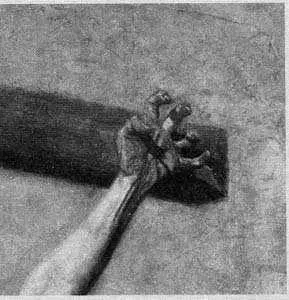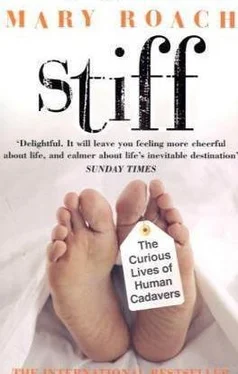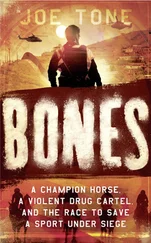LEAP, for its part, turned out to be a valuable study. The sandal myth was mildly vindicated (the injuries were about as severe as they were with a combat boot), and one boot—Med-Eng’s Spider Boot—showed itself to be a solid improvement over standard-issue footwear (though a larger sample is needed to be sure). Harris considers the project a success, because with land mines, even a small gain in protection can mean a huge difference in a victim’s medical outcome. “If I can save a foot or keep an amputation below the knee,” he says, “that’s a win.”
It is an unfortunate given of human trauma research that the things most likely to accidentally maim or kill people—things we most need to study and understand—are also the things most likely to mutilate research cadavers: car crashes, gunshots, explosions, sporting accidents. There is no need to use cadavers to study stapler injuries or human tolerance to ill-fitting footwear. “In order to be able to protect against a threat, whether it is automotive or a bomb,” observes Makris, “you have to put the human to its limits. You’ve got to get destructive.”
I agree with Dr. Makris. Does that mean I would let someone blow up my dead foot to help save the feet of NATO land mine clearers? It does. And would I let someone shoot my dead face with a nonlethal projectile to help prevent accidental fatalities? I suppose I would. What wouldn’t I let someone do to my remains? I can think of only one experiment I know of that, were I a cadaver, I wouldn’t want anything to do with. This particular experiment wasn’t done in the name of science or education or safer cars or better-protected soldiers. It was done in the name of religion.
7. HOLY CADAVER
The Crucifixion Experiments

The year was 1931. French doctors and medical students were gathered in Paris for an annual affair called the Laennec conference. Late one morning, a priest appeared on the fringes of the gathering. He wore the long black cassock and Roman collar of the Catholic Church, and he carried a worn leather portfolio beneath one arm. His name was Father Armailhac, he said, and he sought the counsel of France’s finest anatomists. Inside the portfolio was a series of close-up photographs of the Shroud of Turin, the linen cloth in which, believers held, Jesus had been wrapped for burial when he was taken down from the cross. The shroud’s authenticity was in question then, as now, and the church had turned to medicine to see if the markings corresponded to the realities of anatomy and physiology.
Dr. Pierre Barbet, a prominent and none-too-humble surgeon, invited Father Armailhac to his office at Hôpital Saint-Joseph and swiftly nominated himself for the job. “I am… well versed in anatomy, which I taught for a long time,” he recalls telling Armailhac in A Doctor at Calvary: The Passion of Our Lord Jesus Christ as Described by a Surgeon . “I lived for thirteen years in close contact with corpses,” reads the next line. One assumes that the teaching stint and the years spent living in close contact with corpses were one and the same, but who knows. Perhaps he kept dead family members in the cellar. The French have been known to do that.
Little is known about our Dr. Barbet, except that he became very devoted, possibly a little too devoted, to proving the authenticity of the Shroud.
One day soon, he would find himself up in his lab, pounding nails into the hands and feet of an elfin, Einstein-haired cadaver—one of the many unclaimed dead brought as a matter of course to Parisian anatomy labs—and crucifying the dead man on a cross of his own making.
Barbet had become fixated on a pair of elongated “bloodstains” [25] Is it really blood on the Shroud of Turin? According to forensic tests done by the late Alan Adler, a chemist and a Shroudie, it most certainly is. According to Joe Nickell, author of Inquest on the Shroud of Turin , it most certainly isn’t. In an article on the Web site of the famed debunking group Committee for the Scientific Investigation of Claims of the Paranormal, Nickell says forensic tests of the “blood” have shown it to be a mixture of red ocher and vermilion tempera paint.
issuing from the “imprint” of the back of the right hand on the shroud. The two stains come from the same source but proceed along different paths, at different angles. The first, he writes, “mounts obliquely upwards and inwards (anatomically its position is like that of a soldier when challenging), reaching the ulnar edge of the forearm. Another flow, but one more slender and meandering, has gone upwards as far as the elbow.” In the soldier remark, we have an early glimmer of what, in the due course of time, became clear: Barbet was something of a wack. I mean, I don’t wish to be unkind, but who uses battle imagery to describe the angle of a blood flow?
Barbet decided that the two flows were created by Jesus’ alternately pushing himself up and then sagging down to hang by his hands; thus the trickle of blood from the nail wound would follow two different paths, depending on which position he was in. The reason Jesus was doing this, Barbet theorized, was that when people hang from their arms, it becomes difficult to exhale; Jesus was trying to keep from suffocating.
Then, after a while, his legs would fatigue and he’d sag back down again.
Barbet cited as support for his idea a torture technique used during World War I, wherein the victim is hung by his hands, which are bound together over his head. “Hanging by the hands causes a variety of cramps and contractions,” wrote Barbet. “Eventually these reach the inspiratory muscles and prevent expiration; the condemned men, being unable to empty their lungs, die of asphyxia.”
Barbet used the angles of the purported blood flows on the shroud to calculate what Jesus’ two positions on the cross must have been: In the sagging posture, he calculated that the outstretched arms formed a 65-degree angle with the stipes (the upright beam) of the cross. In the pushed-up position, the arms formed a 70-degree angle with the stipes.
Barbet then tried to verify this, using one of the many unclaimed corpses that were delivered to the anatomy department from the city’s hospitals and poorhouses.
Once Barbet got the body back to his lab, he proceeded to nail it to a homemade cross. He then raised the cross upright and measured the angle of the arms when the slumping body came to a stop. Lo and behold, it was 65 degrees. (As the cadaver could of course not be persuaded to push itself back up, the second angle remained unverified.) The French edition of Barbet’s book includes a photograph of the dead man on the cross. The cadaver is shown from the waist up, so I cannot say whether Barbet dressed him Jesus-style in swaddling undergarments, but I can say that he bears an uncanny resemblance to the monologuist Spalding Gray.
Barbet’s idea presented an anatomical conundrum. For if there were periods when Jesus’ legs gave out and he was forced to hang the entire weight of his body off his nailed palms, wouldn’t the nails rip through the flesh? Barbet wondered whether, in fact, Jesus had been nailed through the stronger, bonier wrists, and not the flesh of the palms. He decided to do an experiment, detailed in A Doctor at Cavalry . This time, rather than wrestle another whole cadaver onto his cross, he crucified a lone arm. Barely had the owner of the arm left the room when Barbet had his hammer out:
Having just amputated an arm two-thirds of the way up from a vigorous man, I drove a square nail of about 1/3 of an inch (the nail of the Passion) into the middle of the palm…. I gently suspended a weight of 100 pounds from the elbow (half the weight of the body of a man about 6 foot tall). After ten minutes, the wound had lengthened; …I then gave the whole a moderate shake, and I saw the nail suddenly forcing its way through the space between the two metacarpal heads and making a large tear in the skin…. A second slight shake tore away what skin remained.
Читать дальше













